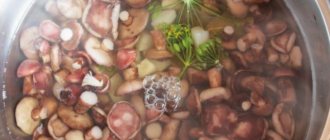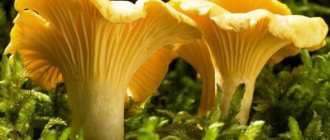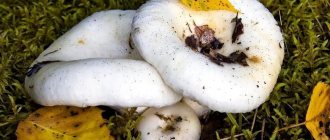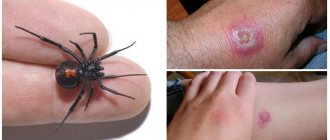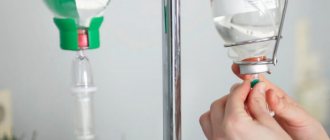We all love pickled mushrooms! In the cold winter I sat down at the table, opened a jar and filled it with sour cream and potatoes... mmm!
However, such an ideal picture can be spoiled by mold.
Why mold appears on salted mushrooms, and what to do about this problem, read on.
We recommend reading: “Mold has appeared on salted tomatoes: what to do”
Soured brine in saffron milk caps: how to save sour mushrooms?
If the brine in the saffron milk caps has turned sour, the preparations may have been stored incorrectly. With any method of pickling, mushrooms are stored either in the refrigerator or in a dark, cool and well-ventilated room, the temperature of which is not higher than +10°C.
Do you use expired food for cooking at home?
Yes, the main thing is to process it if it is meat or expired kefir for pancakes.
33.57%
No, it is very dangerous and not useful.
27.14%
If the products have fungus or mold, then we throw them away; if they are a couple of days past their expiration date, we use them for food, even without heat or other treatment.
39.29%
Voted: 140
If the brine has acquired an unpleasant odor, and the mushrooms were cooked quite recently (1-5 days ago), then the situation can be corrected. The following steps need to be taken:
- The saffron milk caps are removed from the container, washed thoroughly in several passes and boiled in boiling water with the addition of a pinch of citric acid for no more than 5-7 minutes.
- Place in a colander and leave for a few minutes to drain well.
- Distribute the mushrooms into dry sterilized jars and fill them with fresh brine or marinade.
- Sterilize in hot water for 20 minutes and close with tight nylon lids.
- Allow to cool completely and only then take it to a cool place.
- If the brine has turned sour more than 5 days ago, it is better to throw away the mushrooms, without sparing your labor and wasted time.
Rules for storing salted fruits
To prevent mushrooms from molding in a jar or other container, certain storage rules should be followed. Firstly, the containers in which supplies will be stored must be sterile.
Read also: Propagation of phlox by cuttings in summer
Jars must be sterilized, and pots, buckets and barrels must be thoroughly washed, scalded with boiling water and dried. If you do not sterilize the dishes well enough, the supplies will spoil even if other conditions are met.
Finding appropriate storage space is equally important. It should be fairly dry and dark. The room temperature should not fall below zero and rise above 6°C. If the temperature drops below zero, the products will freeze, become brittle and lose their taste. If the temperature is too high, mold may begin to grow.
If there is no appropriate room, then supplies can be stored in the refrigerator. You can also store pickles on a glassed-in balcony. To do this, the cans must be placed in boxes and insulated using old blankets, batting, wood shavings, sawdust, etc.
It is important to use the correct storage containers. You can use containers made of enameled metal, glass and wood. Clay, galvanized tin, aluminum or plastic utensils should be avoided. Do not cover the product with a bag, cling film or parchment paper, as this will create an ideal environment for mold to grow.
Saffron milk caps have turned sour under oppression: how to fix soured mushrooms?
If saffron milk caps have soured under pressure and mold has formed on the surface, some cooks, as mentioned above, value their health and life more. Therefore, they throw away the mushrooms without delay, without taking any action. But if this happened just a few days after salting and the saffron milk caps turned sour, what should you do in this case?
- Rinse the gauze well in hot water with vinegar.
- Wash the oppression and the plate lying on the mushrooms, and then pour boiling water over it.
- Remove mold, drain all the brine and rinse the mushrooms well in several waters.
- Place them again in a washed container and fill them with new brine at the rate of 1 tbsp. l. salt per 1 kg of mushrooms.
How to properly salt saffron milk caps so they don’t go sour
To prevent salted saffron milk caps from fermenting, it is necessary to take the pickling procedure seriously from the very beginning, strictly following all preparation instructions.
First of all, if dry salting is not used, it is necessary to carefully free the mushrooms from plant debris and especially particles of earth or sand using water. But you should remember that you shouldn’t soak the saffron milk caps in water for a long time.
Many housewives use exclusively hot salting to prevent saffron milk caps from turning sour. That is, boil the mushrooms before salting or at least pour boiling water over them.
Salt must be added at the rate of 1.5 cups per 10 liter bucket of saffron milk caps.
Since salt is the main preservative, it is better to slightly overdo it than to undersalt it. The salty solution will prevent the mushrooms from turning sour. And if it is too salty, then when eating the saffron milk caps, you can lightly rinse them in cold running water.
The pickling container should be enameled, glass, ceramic or wooden. Under no circumstances should you use metal utensils.
What should you do if the saffron milk caps start to turn sour in the jars?
Salted saffron milk caps are perfectly stored in jars and are considered a delicious snack on any holiday table. But sometimes there are problems here too - saffron milk mushrooms turn sour when stored in a jar.
Often, housewives who encountered similar situations assured that they did everything according to the recipe and observed the storage conditions, but the saffron milk caps still turned sour. What should you do if the saffron milk caps start to turn sour in the jars? Perhaps something was still missed or overlooked. Sometimes, completely adhering to the cooking instructions, but just a little without rolling the lid all the way, the problem of mushrooms souring arises, and the preparation may deteriorate. Perhaps the initial processing was poorly carried out and dirt remained in the product. In addition, spices and spices can also cause souring of fruit bodies.
If air bubbles appear in the jar 3-4 days after preparation, the product can be saved: how to fix soured saffron milk caps?
- Pour out the contents of the jars: rinse the mushrooms thoroughly in several waters, sterilize the jars for at least 10 minutes over steam or in boiling water.
- Boil the mushrooms in water with the addition of citric acid (take 1 pinch for 1 water) for 5-7 minutes.
- Rinse in hot water, place in sterilized jars, add fresh marinade or brine and place in hot water for sterilization.
- Sterilize for 10-15 minutes over low heat.
- Roll up, turn upside down and see if the rolled up lids leak. If liquid has leaked under the lids, repeat the sealing process with another lid.
Sometimes cooks have a problem - the saffron milk caps have gone sour. Many people decide to immediately get rid of the snack and throw it away so as not to endanger their health and the health of their loved ones. Others are starting to look for information on how to save soured saffron milk caps.
Answers to common questions
When identifying mold on salted mushrooms, housewives may have many questions. The most common ones are discussed below:
Proper preparation and storage of salted mushrooms will help preserve the taste of this snack for a long time. If mold does appear, do not rush to throw away supplies. In most cases they can be saved. To do this, it is necessary to immediately carry out a number of specific actions. If mold is not detected in time, the supplies will have to be thrown away. Eating spoiled foods can be harmful to your health.
As soon as people learned about mushrooms and their properties, they began to be actively introduced into the daily menu. Milk mushrooms are especially rich in vitamins and also have excellent taste - one of the most common fruiting bodies.
Salted and pickled milk mushrooms have long been considered the most popular among mushroom pickers. They occupied a place of honor at any festive feast, because they were always prepared in large quantities for the winter. There are a large number of different recipes for salting and pickling milk mushrooms. Salted mushrooms have never lost their popularity: they are widely used as an independent snack, they are added to salads, and they are used as first and second courses.
However, there is a problem that is inherent in all pickled mushrooms. The fact is that mold can appear on them - how to protect milk mushrooms from this trouble? Housewives, seeing mold on their workpieces, begin to sound the alarm and seek advice from those who have already encountered such a problem.
We offer several options showing how to remove mold from milk mushrooms if it appears after pickling or salting in jars, barrels and other containers.
Why do dried mushrooms smell stronger?
There is a fairly common belief that dried mushrooms smell stronger. In fact, this applies mainly to porcini mushrooms. All other mushrooms lose their flavor when dried. In general, when drying mushrooms, fermentation processes occur, during which the number of volatile aromatic components increases and the dried mushroom acquires a familiar smell. Similar processes occur when tobacco leaves are dried and coffee beans are roasted.
The effects of mushrooms on the body and their chemical composition have been studied in some detail. Everyone knows that both poison and medicine can be obtained from mushrooms. All these aspects are described in detail in scientific and popular literature. However, the chemistry of mushrooms from a gastronomic and aromatic point of view is rather poorly described. Today we will try to fill this gap and the first point is the smell of mushrooms.
Rules for collection, processing, preparation and storage
Health comes first, therefore, no matter how much you love mushrooms and no matter how experienced a lover of “silent hunting” you are, it would not be amiss to recall some of the nuances listed below.
- Mushrooms must be collected very carefully, cutting them without mycelium. Immediately you need to clean the leg of any remaining soil, leaves and needles.
- Old and overripe specimens should not be cut off, because it will not be possible to clean them well from the soil. For example, if you are collecting milk mushrooms, look carefully: they grow in families, and next to the mature ones there are also young, fresh mushrooms, so put them in the basket.
- By the way, about the basket, the most environmentally friendly container for collection is a basket made of willow twigs. It is well ventilated, and any soil that accidentally gets in immediately pours out through the rods.
- For preventative purposes, you need to rinse it several times, and boil it twice, draining the first water.
- To avoid botulinum toxin poisoning, methods of pickling, drying, and salting are recommended. Canning is not included in this list, since it is in the canned product that an airless environment favorable for botulism is formed.
The dried product should be stored in a glass container or fabric bag in a dry, dark, cool place. The ideal option is a cellar. It is advisable to keep pungently smelling vegetables (garlic, onions) separately. If the mushrooms become damp, they must be dried in the oven - this will prevent the spread of dangerous mold.
Poisoning with dry mushrooms can occur if they have been stored for several years: this way they not only lose their taste and aroma, but also accumulate toxins, becoming dangerous to human health.
There are no similar posts
What do mushrooms smell like?
It would seem like a rather strange question. The smell of mushrooms cannot be confused with anything else; there is even such a thing as “mushroom aroma.” But if you look at it, each mushroom smells differently and has only its own inherent shades in its aroma. It is believed that the unpleasant odor is the prerogative of inedible mushrooms. Some experienced mushroom pickers can even tell by smell whether a mushroom is edible or not. For example, the toadstool has a sweetish aroma. Amanita toadstool smells like rotten potatoes. In general, fly agarics are the most unpleasant-smelling mushrooms. One of its species is even called “smelly”. It looks like champignon, but it smells like phenol. This is a deadly poisonous mushroom! Very often the smell of poisonous mushrooms is similar to radishes.
But not all not-so-pleasant-smelling mushrooms are poisonous. There is such a mushroom - milkweed. When raw it smells like herring, but when fried it tastes like meat. Valuy has a pungent taste and a musty smell, but when properly prepared, this mushroom becomes a real culinary masterpiece. But there are very few such edible types of mushrooms and they are quite rare, so it is better to avoid mushrooms that have a bad smell.
How to identify spoiled fresh mushrooms
Often, after collecting mushrooms, they are first eaten fresh (boiled or fried) and only after that the remaining volume is pickled.
Often, during storage, the product manages to deteriorate a little, so that obviously spoiled mushrooms are used for twisting. Naturally, such preservation will not be stored for long and, most likely, will sour in the first month.
This is why it is important to determine the freshness of mushrooms before they go into jars.
- The shelf life of collected mushrooms is no more than a week in the refrigerator. After washing and cleaning, the product can be stored in a cool place for no more than half a day.
- Mushrooms should not smell unpleasant - the aroma should have an earthy note, but not too strong.
- Fresh mushrooms are characterized by low moisture and elasticity. Excessive fragility or, on the contrary, moisture indicates deterioration of the product.
- The color of the mushroom should be characteristic of its variety - changes in shade often appear when the product rots.
- The part of the mushroom that deteriorates first is the area under the cap. If there are any stains on it, it has become damp or too brittle and has changed its shape, most likely the mushroom has begun to deteriorate.
If you find one or more of the signs listed above, it is better to avoid using such mushrooms as an ingredient for pickling.
As a last resort, you can go through the entire volume and throw away only the spoiled mushrooms, or cut off those parts that have begun to deteriorate. Also, with a product that is not very fresh, you should increase the cooking time, but only if the signs of partial spoilage are not too strong.
The smell of mushrooms from a chemical point of view or Why mushrooms smell
The smell of mushrooms is very difficult to translate into chemical formulas. It is not just any individual molecules that are responsible for the aroma of a mushroom, but mixtures of substances with different concentrations. Even if characteristic compounds are found in some types of mushrooms, this does not give us final confidence that they are the problem. For example, norisoprenoids are found in various types of buttermilk: trans-geranylacetone and (E,E)farnesylacetone, but whether these compounds really characterize the aroma of buttermilk is not known. The aroma of fresh chanterelles, according to many, is reminiscent of apricot. True, the lists of characteristic aromatic compounds of chanterelles and apricots almost do not overlap; they only have 1-octen-3-ol and hexanal in common, but neither of them smells like fruit. The terpenoids dihydroactinidiolide and limonene are responsible for the fruity smell of chanterelles, while benzaldehyde (almond aroma) and phenylacetaldehyde (honey pink) are responsible for the floral notes. Apparently, the combination of these substances gives chanterelles their apricot note. The porcini mushroom with its unique aroma is rightfully considered the king of mushrooms. The broth made from whites also has a special taste. In addition, the aromas of porcini mushrooms tend to intensify during drying and storage: after six months, the concentration of aromatic compounds in dried mushrooms increases sharply, tens of times for furans and pyrazines. Another sign of the aroma of dried mushrooms is the high concentration of methional. The smell of fresh mushroom is dominated by the same aliphatic alcohols and ketones that are responsible for the general mushroom taste. But during cooking and especially during drying, a number of reaction products are formed between amino acids and sugars: a mixture of pyrazines (methylpyrazine, 2,5-dimethylpyrazine), furans (furfural, 5-methyl-2-formylfuran), pyrroles and thiazoles. All of these compounds are characterized in one way or another by a roasted or brothy aroma, which, together with a common mushroom note (1-octen-3-ol and 1-octen-3-one), gives dried whites their unique smell. Sometimes mushrooms smell similar to cooked meat, and this is no coincidence. For example, 2-methyl-3-furanthiol is a characteristic component of meat odor.
The most famous mushrooms that do not grow in the wild in Russia are perhaps truffles and shiitake mushrooms. There are quite a few types of truffles, but two are considered the most noble and aromatically interesting - black and white truffles. Actually, the smell of mushrooms is their main value, and it is not surprising that the aromas of truffles are the best studied. Among the many myths surrounding truffles, there is one chemical one. For some time it was believed that the unique smell of truffle mushrooms was caused by androstenol, which was discovered through chemical analysis. Indeed, the temptation to make a mistake was great, because androstenol is the pheromone of boars, which have always been used to search for these mushrooms. However, further studies showed that the main contribution to the smell of mushrooms comes from simple sulfur-containing compounds. For black truffles, these are primarily dimethyl sulfide and dimethyl disulfide, and for white truffles, bis-(methylthio)-methane. In fact, it is by the smell of dimethyl sulfide that pigs and dogs find the mushroom. This compound itself smells like boiled cabbage and seaweed, so it’s not surprising that not everyone loves truffles.
Shiitake mushroom is cultivated as widely as champignons, and with the advent of oriental restaurants, it is no longer exotic for us. Shiitake has a unique aroma that develops when dried. It is caused by a rather unusual chemical called lenthionine. It is not present in fresh mushrooms, but when the cell walls are damaged (especially during drying), not only lenthionine is formed, but also related aromatic components.
Let's summarize some results. Mushrooms are a special group of living organisms: at the biochemical level they are similar to both plants and animals. For example, the components of the cell walls of fungi, chitin and chitosan, are related to fungi with insects and crustaceans, and our body does not absorb these compounds. On the other hand, mushrooms are rich in amino acids, including essential ones. But the main, almost intangible value is the magnificent aromas: porcini mushroom broth, crispy saffron milk caps, white truffle. I wonder if this autumn will be a mushroom one?
The most famous mushrooms that do not grow in the wild in Russia are perhaps truffles and shiitake mushrooms. There are quite a few types of truffles, but two are considered the most noble and aromatically interesting - black and white truffles. Actually, the smell of mushrooms is their main value, and it is not surprising that the aromas of truffles are the best studied. Among the many myths surrounding truffles, there is one chemical one. For some time it was believed that the unique smell of truffle mushrooms was caused by androstenol, which was discovered through chemical analysis. Indeed, the temptation to make a mistake was great, because androstenol is the pheromone of boars, which have always been used to search for these mushrooms. However, further studies showed that the main contribution to the smell of mushrooms comes from simple sulfur-containing compounds. For black truffles, these are primarily dimethyl sulfide and dimethyl disulfide, and for white truffles, bis-(methylthio)-methane. In fact, it is by the smell of dimethyl sulfide that pigs and dogs find the mushroom. This compound itself smells like boiled cabbage and seaweed, so it’s not surprising that not everyone loves truffles.
-Music
-Statistics
The mushrooms turn out crispy, spicy and somehow alive. One drawback is that it is very difficult, every time you look into the refrigerator, stumble upon these mushrooms and bravely wait the allotted 1.5 months for ripening.
This method is good to use in camping conditions, when it is not possible to bother with preparing brine and boiling. Mushrooms prepared in this way can ripen for up to two weeks at room temperature (but it is advisable that the temperature does not exceed 24°C, otherwise the mushrooms will ferment too quickly and may become inedible). If there is no suitable container, then the mushrooms can be salted in plastic food bags, and then, upon arrival home, transferred to jars. When dry salting, you don’t need to use any spices. Or you can add the spices later, when transferring them to jars. The dry salting method is suitable for almost all types of mushrooms. The only exceptions are those mushrooms that require pre-soaking (valui, bitter mushrooms). And I would also not recommend salting umbrellas, raincoats and honey mushrooms - they turn out to look like rags. And also russula - they are too brittle. Although russula and meadow mushrooms can be salted hot. And dry salting is not very suitable for champignons. It is recommended to soak pork mushrooms, milk mushrooms, volnushki and white mushrooms for 3 days in brine before salting (for 1 liter of water - 10 g of salt and 2 g of citric acid), but I salt them without soaking. And some more advice from my own experience. It is advisable, but not necessary, to salt different types of mushrooms separately - milky, lamellar and tubular.
COMPOSITION For 1 kg of mushrooms - 30 g salt, 1 clove of garlic (cut into slices), fresh dill
It is better not to wash tubular and lamellar mushrooms with loose pulp. Sort through, clean off debris, and wipe with a slightly damp cloth if necessary. Soak milk mushrooms, which have a bitter taste, for several days beforehand - soak white mushrooms, volnushki, nigella mushrooms 2
Is it possible to eat honey mushrooms with a white coating?
When honey mushrooms become covered with a white coating during salting, this is a natural process. Typically, such a coating covers the cloth or gauze that covers the product; it must be changed from time to time with a clean one soaked in vodka.
Important! If mold has touched the mushrooms, the damaged layer should be thrown away.
You cannot eat mushrooms covered with mold. They accumulate hazardous toxins that can cause fever, vomiting, dizziness and other unpleasant symptoms. Biologists classify mold as belonging to the kingdom of microscopic fungi. They have a similar structure to the large, edible specimens familiar to people, only several thousand times smaller.
All representatives of the kingdom have a root system - mycelium, which absorbs nutrients from the soil, and above the ground there is a fruiting body - a reproductive organ containing millions of spores. It is the ancestor of mycelium or mycelium. When exposed to favorable conditions, it produces many branched shoots-threads. They grow by absorbing and processing nutrient substrate. The process has two phases: the first is the growth of threads and the second is the formation of the body. New spores mature in it.
Colonies of mold fungi have different colors - gray, black, yellow, green, reddish. Mold causes allergies; it affects the body invisibly, like radiation and heavy metals. The most dangerous mold is black aspergillus. To see it, sometimes it’s enough to look into the cellar where food supplies are stored. If you notice mold on the surface of canned food, you should throw it away without regret. By scraping off the upper, moldy part, you can remove only the visible side of the “iceberg”, and the toxins produced by the mushrooms will remain inside the product.
Mycotoxins are not destroyed even by boiling, and slowly accumulate in the body. These substances are pathogenic even in small concentrations. They affect the liver and can cause malignant tumors. Therefore, you need to throw away food even if there is a small island of mold on it, and never take moldy specimens from the forest.
But mold may not be visible; often canned food is already contaminated before it reaches the table. This is especially true for canned food bought secondhand at spontaneous markets.
How to preserve properly
In order for harvesting from the gifts of the forest to only please you, you need to engage in canning responsibly, without neglecting any “little things”. Do-it-yourself in the recipe is not allowed - if you are supposed to put a certain amount of salt in the marinade and use a certain amount of citric or acetic acid, you must strictly follow these recommendations.
If it is possible to autoclave the mushrooms, do so. This method will very well protect your homemade preparations.
Use the old-fashioned way of sealing jars - parchment paper: it will provide access to atmospheric oxygen and will not allow harmful bacteria to “raise their heads”.
Avoid recipes where mushrooms are poured with boiling marinade, but not boiled or boiled. This may be hazardous to your health. If you are still confident in this recipe and it has “never let you down,” then at least keep the mushrooms prepared in this way in the cold for ten days and only then use them for food. In general, do not store it for a long time, it is a perishable product.
You should store jars of butter and milk mushrooms where there is no light and it’s cold. If you live outside the city, then in the cellar. If you are a city dweller - in the refrigerator. The temperature should not exceed six degrees Celsius. And another important thing: even under ideal storage conditions, it is advisable to eat them within a year, no later. Otherwise, the mushrooms may still spoil. [ads-pc-2] Before serving the mushrooms, take the time to boil them for half an hour in advance. Or you can use them not as an independent snack, but as a semi-finished product - fry or bake with the addition of some other products.
Causes and types of mold
Salted mushrooms become moldy for several reasons; knowing them, you can avoid this problem. Factors favoring the development of fungus are:
- Poorly sterilized container. If the container is not properly disinfected or sterilized, mold will begin to develop inside it.
- Violation of temperature conditions during storage of supplies. Too high a room temperature promotes the accelerated development of harmful bacteria and fungi.
Mold on salted mushrooms
- Insufficient salt or other preservatives. When salting food, it is important to strictly adhere to the recipe. Spices that are used for pickling not only give a special taste to the dish, but also have preservative properties. It is especially important to use enough salt.
- The jar is not completely filled. Air that remains in containers that are not completely filled contributes to the growth of mold. Enough saline solution must be used. It should completely cover the contents. The remaining space can be filled with vegetable oil.
Pickled mushrooms
If one or more rules for preparing mushrooms are violated, mold mushrooms of white, bluish, yellow-green or black color begin to develop in the container with them. If the supplies are covered with a thin layer of light mold, they can be saved. Black mold formations are dangerous; their spores can enter a person’s lungs and cause irreparable harm to health.
Botulism in salted and pickled mushrooms
The risk of mushroom poisoning is much higher if you are dealing with pickled or salted products. Fried and boiled boletus, boletus, and chanterelles do not pose such a danger. This is why some radical doctors recommend abandoning pickling in favor of other types of mushroom processing.
If you are still going to pickle mushrooms, competent technology for processing forest gifts can reduce the risk. First of all, you cannot roll up jars with metal lids: under them, bacilli isolated from atmospheric oxygen will begin to do their dirty work. The solution is to give preference to plastic lids, they are safer in this situation.
Often, buyers are tempted by sellers at markets and markets with pickled or salted mushrooms in rolled up jars (“Everything is sterile, safe!”). It is very difficult for a city person who cannot wander through the forest in search of mushrooms to resist such a temptation, but he must! After all, even if products prepared with one’s own hands may turn out to be dangerous to eat, let alone those prepared by who knows what hands. Who guarantees that the mushrooms have been properly cleaned from soil, moss, grass and leaves? What if poisonous bacilli are salted and pickled along with your favorite saffron milk caps and buttermilk?
Silent hunting: the result must be safe
In the autumn, on the highway along the forest, you constantly come across parked cars without owners. These mushroom pickers went fishing. Mushroom picking is not only a concern for the variety of the menu, but also a wonderful vacation, which is why many residents of megacities spend the whole weekend in the forest.
There are also passionate mushroom pickers who set their own records for mushroom picking, and then proudly show the results to their family and neighbors. Among mushroom hikers, few people think about the danger, namely the presence of botulism in collected mushrooms. And in vain. Mushrooms occupy a leading position among foods dangerous for botulism.
Signs of botulism in canned mushrooms
What signs should cause you alarm if you “by eye” determine the quality of your mushroom preparations before serving:
- the solution in which the mushrooms are located has turned from transparent to cloudy;
- the metal lid is swollen (experts call this phenomenon “bombing”);
- Tiny bubbles rush from the bottom of the jar to the lid.
Although we must keep in mind that even products that are ideal at first glance, without all the listed dangerous signs, can pose a threat to your health: such a dangerous and cunning enemy is botulism.
Impossible to recognize
You will not see signs of the disease with the naked eye. As, indeed, with an armed eye. Clostridia does not manifest itself in any way either in a calm state or in the process of active toxin production. All that is required to activate it is the absence of air.
You will object that they should look for signs? The lid on a jar of mushrooms is swollen - here's your proof! Or the mushrooms have simply become cloudy, we’ll throw them out too!
Regarding the throwing away of conservation that has lost its charm, you are absolutely right. But the fact that clostridium botulism is raging in a jar with a swollen lid is not very good. Cloudiness of the brine, an abundance of gases in a jar of canned mushrooms are signs of the presence of other bacteria that can cause poisoning. Clostridia is a modest lady and does not have such strong gas-forming abilities. While producing a toxin, it does not in any way affect the quality of home canned food. Mushrooms can be very tasty, and signs of the disease can only be determined after the latent (incubation) period has ended.
We recommend reading: If the Cream is Hermetically Packed
What is botulism in mushrooms
Pathogenic bacteria live in hermetically sealed canned mushrooms without oxygen, producing a deadly poison. Doctors say that even 0.035 milligrams of this substance is a dose sufficient to cause death. The dangerous toxin is extremely resistant to acids, as well as to large amounts of salt used in canning. The poison is not afraid even of boiling: three to five hours on the stove will not give the expected disinfecting effect.
Botulism, provoked by spoiled canned mushrooms, occurs at varying degrees of speed - after four hours or after three days. Doctors note that the rapid course of the disease is especially dangerous. Among its symptoms, which help to make a more accurate diagnosis, is blurred vision (this does not happen with ordinary poisonings). Later, the patient may lose speech, muscle paralysis will change his appearance beyond recognition, and the main cause of death is respiratory arrest. In any case, regardless of the speed of development of the disease, time works against a person, and medical help must be sought immediately.
According to statistics, 84 percent of people with botulism ate home-made canned mushrooms. The remaining percentage is “on the conscience” of the sausage and homemade meat preparations.
Canned mushrooms made industrially, as a rule, are above suspicion because high-temperature methods of sterilizing mushrooms are used in their production.
What signs should cause you alarm if you “by eye” determine the quality of your mushroom preparations before serving:
The main symptoms of this food poisoning
Since such a disease does not begin immediately after the penetration of these bacteria into the human body, the main symptoms also do not appear immediately. Moreover, they appear suddenly, a few hours after eating - when the contaminated food has already been digested in the gastrointestinal tract.
The main signs and severity of poisoning depend on how many of these harmful bacteria enter the human digestive system. That is, the more a person has eaten mushrooms infected with botulism, the more severe the poisoning of the body will be. If a person discovers similar symptoms of botulism, then it is necessary to urgently call an ambulance.
We must remember that as soon as the symptoms of this food poisoning appear, medical attention is needed for the first 24 hours - it is during these 24 hours that the highest percentage of mortality due to botulism occurs. Botulism is the most dangerous of all types of food poisoning, so the patient must describe all the symptoms that have arisen in his body so that the doctor can make the correct diagnosis. The remains of mushrooms must be taken for laboratory tests.
Botulism does not develop where there is access to fresh air
Fickle chanterelles
Even experienced mushroom pickers, who know exactly what they put in the basket and how to cook it, sometimes end up with a completely inedible dish. What's the matter? After all, there are chanterelle mushrooms in the frying pan. Why do they taste bitter, although they were tasty when collected a week earlier in the same place? The answer is simple: climate. If there is not enough moisture, the juice inside the fruiting bodies becomes bile. Therefore, mushrooms collected in the summer heat taste bitter. The same applies to chanterelles found in moss in a spruce forest - the acrid taste of resin makes them practically inedible.
How to sterilize jars and lids correctly
To prevent the preservation from deteriorating during storage and to prevent the cucumbers from becoming covered with a white coating, you should approach the issue of sterilizing jars and lids responsibly. This can be achieved in several ways:
- Using steam;
- Boiling;
- In an electric oven;
- Microwave;
- Using potassium permanganate.
Before the sterilization process, you should ensure the integrity of the jars and lids. The necks of the jars should be without a single chip, and the lids should in no case be bent. The jars should be thoroughly washed with laundry soap or soda.
Steam sterilization is carried out using a pan of boiling water and a rack for jars, which are installed with the neck down. You can immediately put the lids in the same boiling water. The jar has achieved sterility when large drops of moisture appear on its inner surface. You can put food in a jar only after it has completely dried.
When boiling, the jars should be completely covered with water in the pan. This method is convenient for small jars. The water with the jars should be heated gradually so that they do not burst. The jars are considered sterile after boiling for 5 minutes.
In an electric oven (oven) you can sterilize many jars at once. Place the washed jars in the oven, neck down, and set the temperature to 120 degrees for 12 minutes.
Porcini mushrooms are bitter
- When collecting porcini mushrooms, a false mushroom was caught in the basket. This is the main reason for the possible appearance of bitterness (more than 90%). Quite often, the gall mushroom is mistaken for boletus, since these mushrooms have a visual similarity. The gall mushroom is a harmless double, not poisonous and not dangerous to humans, but has a pronounced bitter taste. When cooked, such a mushroom will spoil the taste of other mushrooms. Also similar in appearance is the boletus mushroom and the poisonous satanic mushroom. When collecting porcini mushrooms, be extremely careful.
- Boiling of porcini mushrooms took place together with other representatives of the mushroom kingdom that have a bitter taste. These include: milkmen, valui, violins. When assembling and cooking, boletus mushrooms are best placed separately from other mushrooms.
- Spoilage of porcini mushroom, which is caused by environmental weather conditions, improper storage and the beginning of the rotting process.
Porcini mushrooms do not have a bitter taste. If you find a mushroom with bitterness, it is better not to risk your health and throw away such a mushroom.


